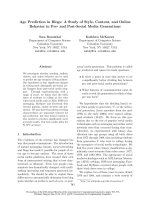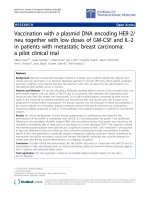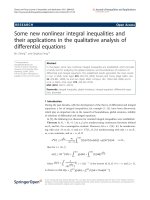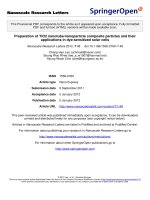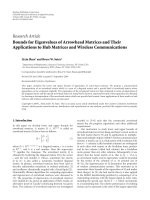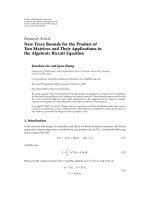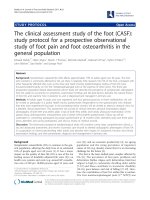Study of sample preparation and pretreatment methods and their applications, in combination with high resolution chromatography
Bạn đang xem bản rút gọn của tài liệu. Xem và tải ngay bản đầy đủ của tài liệu tại đây (1.69 MB, 117 trang )
STUDY OF SAMPLE PREPARATION AND
PRETREATMENT METHODS AND THEIR
APPLICATIONS, IN COMBINATION WITH
HIGH-RESOLUTION CHROMATOGRAPHY
ZHU XUERONG
NATIONAL UNIVERSITY OF SINGAPORE
2005
STUDY OF SAMPLE PREPARATION AND
PRETREATMENT METHODS AND THEIR
APPLICATIONS, IN COMBINATION WITH
HIGH-RESOLUTION CHROMATOGRAPHY
BY
ZHU XUERONG
(M.SC.)
A thesis submitted for the degree of
DOCTOR OF PHILOSOPHY
Department of Chemistry
National University of Singapore
2005
ACKNOWLEDGMENTS
Here I wish to express my sincere gratitude to my supervisor, Professor Hian
Kee Lee for his inspiring guidance, encouragement and tolerance throughout the
entire project.
I would also like to thank Ms Frances Lim and Ms Tang Chui Ngoh for their
kind assistance.
I thank my fellow students He yi, Zhu Liang, Shen Gang, Tu Chuan Hong and
Chanbasha Basheer for their help and encouragement.
The financial assistance provided by the National University of Singapore
during my PhD candidature is also greatly appreciated
.
Last but not least, I want to express my thanks and acknowledgement to my
beloved wife, Li Qing Qing, without whose understanding and encouragement, this
thesis would certainly not have been possible.
i
CONTENTS
ACKNOWLEDGMENTS I
CONTENTS II
ABBREVIATIONS IV
LIST OF PUBLICATIONS VI
SUMMARY VII
CHAPTER 1 1
GENERAL INTRODUCTION 1
1.1 GENERAL REMARKS ABOUT SAMPLE PREPARATION METHODS 2
1.2 OVERVIEW OF SAMPLE PREPARATION METHODS 5
1.2.1 MICROWAVE-ASSISTED EXTRACTION 5
1.2.2 SOLID PHASE EXTRACTION 9
1.2.3 SOLID PHASE MICRO-EXTRACTION 22
1.2.4 SUPERCRITICAL FLUID EXTRACTION (SFE) 34
1.3 SCOPE OF THE RESEARCH 45
REFERENCES: 46
CHAPTER 2 55
USING SUPERCRITICAL FLUID EXTRACTION AS A PRETREATMENT
METHOD FOR POLYCHLORINATED BIPHENYLS IN PINE NEEDLES 55
2.1 INTRODUCTION 56
2.2 EXPERIMENTAL 58
2.2.1 CHEMICALS 58
2.2.2 PINE NEEDLE SAMPLE COLLECTION AND PREPARATION 58
2.2.3 SFE 58
2.2.4 CHROMATOGRAPHIC ANALYSIS 60
2.3 RESULTS AND DISCUSSION 60
2.4 CONCLUSION 67
REFERENCES 68
CHAPTER 3 71
ii
DETERMINING POLYCHLORINATED BIPHENYL IN SOIL SAMPLES USING
MICROWAVE-ASSISTED EXTRACTION AND SUPERCRITICAL FLUID
EXTRACTION 71
3.1 INTRODUCTION 72
3.2 EXPERIMENTAL 73
3.2.1 CHEMICALS 73
3.2.2 SOIL SAMPLE COLLECTION AND PREPARATION 73
3.2.3 MAE 73
3.2.4 SFE 74
3.2.5 CHROMATOGRAPHIC INSTRUMENTS AND CONDITIONS 75
GC-ECD 75
GC/MS 76
3.3 RESULTS AND DISCUSSION 76
3.3.1 RECOVERIES OF PCBS USING SFE AND MAE 78
3.4 CONCLUSION 83
REFERENCES 84
CHAPTER 4 86
STUDY OF FRAGRANCE LOSS FROM COMMERCIAL SOAP AFTER USE BY
SPME-GC/MS & OLFACTORY EVALUATION 86
4.1. INTRODUCTION 87
4.2. EXPERIMENTAL 90
4.2.1 SPME 90
4.2.2 MATERIALS AND ANALYSIS 90
4.2.3 SOAP SAMPLE PREPARATION, WASHING AND EXTRACTION 91
4.3. RESULTS AND DISCUSSION 92
4.4 CONCLUSION 100
REFERENCES: 101
CONCLUSIONS 103
iii
A
A
b
b
b
b
r
r
e
e
v
v
i
i
a
a
t
t
i
i
o
o
n
n
s
s
LLE Liquid-liquid extraction
MAE Microwave assistant extraction
SPE Solid phase extraction
SPME Solid phase microextraction
SFE Supercritical fluid extraction
SWE Subcritical water extraction
SLME Supported liquid membrane extraction
ASE Accelerated solvent extraction
LOD Limit of detection
GC Gas chromatography
GC/MS Gas chromatography mass spectrometry
LC/MS Liquid chromatography mass spectrometry
PAHs Polycyclic aromatic hydrocarbons
PCBs Polychlorinated biphenyls
SCX Benzenesulfonic acid
SAX Trimethylammoniopropyl auaternary amine
DEA Diethylammoniopropyl tertiary amine
HPLC High performance liquid chromatography
TMCS Trimethylchlorosilane
PTFE Polytetrafluoroethylene
HLB Hydrophilic lipophilic balanced
PDMS Dimethylsiloxane
PA Polyacrylate
iv
PDMS-DVB Dimethylsiloxane-divinylbenzene
CW-DVB Carbowax-divinylbenzene
CW-TR Carbowax-templated resin
CE Capillary electrophoresis
SFC/MS Supercritical fluid chromatography/ mass spectrometry
Tc
Critical temperature
P
C
Critical pressure
SFC Supercritical fluid chromatography
MPS2 Multi purpose sampler system (Gerstel, Germany)
v
L
L
i
i
s
s
t
t
o
o
f
f
P
P
u
u
b
b
l
l
i
i
c
c
a
a
t
t
i
i
o
o
n
n
s
s
1. Xuerong Zhu and HianKee Lee
GCMS Monitoring PCBs (polychlorinated biphenyls) in Pine Needle sample using
supercritical fluid extraction technique as sample pretreatment method.
Journal of Chromatography A, 976 (2002) 393
2. Xuerong Zhu and HianKee Lee
Determining polychlorinated biphenyls in soil samples using microwave assisted extraction
and supercritical fluid extraction technique.
Poster Presentation of International Symposium, HTC-7, Feb 2002. Belgium
3. Xuerong Zhu and HianKee Lee
Study the fragrance lost profile of two market soap samples after use via SPME-GC/MS &
Olfactive evaluation
Submitted to Journal of Chromatography A, under reviewing.
vi
SUMMARY
In modern analytical chemistry, chromatographic techniques play the most
important roles over other analytical procedures. They have been extensively
employed in environmental, pharmaceutical, toxicological, clinical and food and
flavour, forensic science etc applications. Yet, almost no sample can be injected
into a gas chromatograph or liquid chromatograph directly without pretreatment.
In general, sample preparation takes about two-thirds of the time needed for an
entire analytical procedure. Hence, sample preparation provides a critical
approach in analytical applications.
Sample preparation is complicated by a number of factors, such as: (a).
Concentrations of analytes. In most cases, it is not only necessary to isolate the
components from the matrix but also to concentrate them by several orders of
magnitude; (b). Complicated matrices. For example, some matrices are very
complex and will create problems of foaming and emulsification during the
isolation procedures, with the result that artifacts may be created and analyte may
be lost; (c). Complexities of analytes. In most cases, even a single class of
compounds present in the sample may cover a range of polarities, solubilities,
boiling points and pHs; (d). Instability. In some cases, components are unstable
and may be oxidized by air or degraded by heat or extremes of pH values. Care
should be taken to prevent degradation of such labile analytes.
In order to have a clear picture of each sample preparation method, the
history, advantages and disadvantages, future prospect and combination with other
methods are fully discussed in this study. Just as it is a fact that most of these
vii
techniques may offer unique advantages, they may also suffer several limitations
which may lead to artifact formation, loss of analytes, and proportional changes
during sample preparation. There is no panacea in this field. No single technique
will be optimal for every sample, and evaluations should be made to ensure that
decomposition and loss of desired components do not occur. Nevertheless, there
must be one or several methods that are most suitable under certain circumstances.
Occasionally, a combination of several sample preparation methods may provide
satisfied results. It goes without saying that a good understanding of the chemistry
involved and hands-on experiences are required to select the best isolation and
preparation methods.
This work developed some novel analytical methods, which are mainly
focused on the new sample preparation methods in combination with gas
chromatography and mass spectrometry. For example, for the first time,
supercritical fluid extraction method was applied for the extraction of PCBs from
pine needle sample. The parameters of this method were optimised, including
extraction flow rate, oven temperature, back regulator pressure and extraction time.
Real world pine needle sample was analysed and method was verified. Compared
with traditional methods for extraction of PCBs in pine needle samples, the new
method is simpler, cleaner and almost solvent free. This demonstrated that new
sample preparation methods have great potential and advantages. Another
research topic is about the comparison between microwave assisted extraction and
supercritical fluid extraction. In order to understand the mechanism and
advantages of different new sample preparation methods further and deeper, it is
very necessary to apply them in real sample’s analysis and evaluated their
performances. Detailed results about the recoveries and reproducibility are
viii
reported. A comprehensive comparisons between microwave assisted extraction
and supercritical fluid extraction on PCBs from soil were presented. The last
project is to explain and illustrate how new method, i.e., solid phase
microextraction can be applied into the non-destructive analysis. The fragrance
loss profile of a commercial soap was reported for the first time. The results
obtained explained very well why the smell of a soap changed over time and the
intensity of fragrance were diminished after usage. And provided more scientific
probe on the fragrance loss profile compared with traditional olfactory evaluation.
As most of the methods and applications reported are novel, this thesis provided
valuable information in the sample preparation methods field. A future
perspective and prospect are also included.
ix
CHAPTER 1
GENERAL INTRODUCTION
1
1
1
.
.
1
1
O
O
u
u
t
t
l
l
i
i
n
n
e
e
o
o
f
f
t
t
h
h
e
e
t
t
h
h
e
e
s
s
i
i
s
s
a
a
n
n
d
d
G
G
e
e
n
n
e
e
r
r
a
a
l
l
R
R
e
e
m
m
a
a
r
r
k
k
s
s
a
a
b
b
o
o
u
u
t
t
S
S
a
a
m
m
p
p
l
l
e
e
P
P
r
r
e
e
p
p
a
a
r
r
a
a
t
t
i
i
o
o
n
n
M
M
e
e
t
t
h
h
o
o
d
d
s
s
The thesis begins with an introductory Chapter 1 which reviews several
popular and relatively novel sample preparation methods and describes their
characteristics to provide sufficient background for the research work presented in the
rest of this thesis. Their advantages and disadvantages, and future prospects are
discussed in this thesis whenever necessary.
In Chapter 2, SFE with CO
2
used to extract polychlorinated biphenyls (PCBs)
from pine needle samples is reported for the first time. Results show that SFE with
GC/MS (SIM mode) is a reliable technique to determine PCBs in these samples. It is
demonstrated that SFE is an efficient and relatively clean extraction method for solid
samples.
In Chapter 3, two ways in determining PCBs in soil samples were investigated.
Microwave-assisted extraction (MAE) with hexane-acetone (1:1) and SFE with CO
2
are two recent simpler and more popular ways to determine PCBs in soil sample
compared with traditional extraction methods such as Soxhlet extraction and
chromatographic clean up. High resolution GC with electron-capture detection (ECD)
and GC/MS (SIM mode) were used. The detailed operational procedure and
optimization of SFE and MAE are discussed. A comparison of SFE and MAE is given
as well. Both sets of results are compared with those of Soxhlet extraction. To our
knowledge, this type of detailed comparison has not been carried out previously.
In Chapter 4, the fragrance loss profile of two commercial soaps after
continual use was studied with SPME analysis and traditional olfactory evaluation.
2
SPME was selected here to eliminate the needs of organic solvents or complicated
apparatus. More importantly, SPME keeps the soap intact and makes it possible for
continuous study.
Following are general information about sample preparation methods.
A complete sample analysis procedure includes 5 steps: Sample collection,
sample preparation, sample analysis, data handling and final report generation. The
flow diagram is shown on Figure 1-1.
Figure 1-1. Sample Analysis Flow Diagram
Sample preparation and pretreatment play a vital and indispensable role in
a sample analysis. According to statistical survey results [1], about two-thirds of
the analysis time is typically spent on sample preparation, which requires more
time than sample collection, analysis and data management. The sampling and
preparation steps will cost over 75% of analysis time [2,3]. Thus, anything we can
do to make improvements in this area will translate into advances in time saving
and convenience.
Over the past decades, considerable time has been devoted to improving
analysis speed, resolution, and automation as well as to developing and improving
instrumentation, data-handling and report-generating software, while sample
preparation and pretreatment methods have been more or less neglected. Many
3
traditional sample preparation methods such as liquid-liquid extraction (LLE),
ultrasonic extraction, Soxhlet extraction etc are still widely used, and these
methods are often time consuming and labor intensive. Furthermore, they often
require multiple steps, which are prone to analyte loss and use a large quantity of
organic solvents, most of them are potentially toxic and not environmentally
friendly. Therefore, developing new sample preparation and pretreatment methods
is urgently needed. These needs have driven the development of a wide range of
new sample preparation methods, such as microwave assisted extraction (MAE);
solid phase extraction (SPE); solid phase microextraction (SPME); supercritical
fluid extraction (SFE); subcritical water extraction (SWE); supported liquid
membrane extraction (SLME); accelerated solvent extraction (ASE) and so on.
The inventor of SPME, Pawliszyn has said that the development of sample
preparation is a significant challenge and an opportunity for contemporary
analytical chemists [4].
The objective of sample preparation is to extract the analytes of interest
from a sample matrix, or to remove a complicated matrix. In some cases, the
analytes are present in very low concentrations. Thus, it is necessary to pre-
concentrate and enrich them before any analysis can be carried out. This is to meet
the limits of detection (LOD) of the analytical instrument.
4
1
1
.
.
2
2
O
O
v
v
e
e
r
r
v
v
i
i
e
e
w
w
o
o
f
f
S
S
a
a
m
m
p
p
l
l
e
e
P
P
r
r
e
e
p
p
a
a
r
r
a
a
t
t
i
i
o
o
n
n
M
M
e
e
t
t
h
h
o
o
d
d
s
s
1
1
.
.
2
2
.
.
1
1
M
M
i
i
c
c
r
r
o
o
w
w
a
a
v
v
e
e
-
-
A
A
s
s
s
s
i
i
s
s
t
t
e
e
d
d
E
E
x
x
t
t
r
r
a
a
c
c
t
t
i
i
o
o
n
n
The principle of microwave-assisted extraction is that electromagnetic radiation
is used as a heat source to desorb analytes from their matrices. The microwave
frequency is in the region of 100 GHz to 300 MHz; although this entire
electromagnetic region is potentially available for use, all microwave ovens (for home
or scientific use) operate at 2.45 GHz only [5,6]. The microwave generator is called a
magnetron. Historically, the discovery of the magnetron as a heating source was made
in 1946 by Spencer. The first commercial microwave oven for domestic use appeared
in the marketplace in 1967.
The heating effect of a microwave generator is due to dielectric polarization. The
polarization is achieved by the reorientation of permanent dipoles by the applied
electric field. This means that under microwave conditions, a polarized molecule will
rotate to align itself with the electric field at a rate of about 109 times per second [5].
As the polarisability of a molecule is often represented in terms of dielectric constant,
ε’, it is possible to estimate the ability of the microwave to couple to any molecule by
considering its ε’ values. In the case of microwave-assisted extraction, where samples
are heated using organic solvents, values of the dielectric constant for organic
solvents are required for reference. Table 1-1 listed ε’ values of some commonly used
organic solvents [6].
5
Table 1-1 ε’ Values of Some Extraction Solvents
Solvent Dielectric
Constant (ε’)
Boiling
Point (
°C)
Hexane 1.89 68.7
Dichloromethane 8.93 39.8
Acetone 20.7 56.2
Methanol 32.63 64.7
Acetonitrile
37.5 81.6
Currently there are two ways of using microwaves in scientific research. The first
one is microwave digestion. The use of industrial-grade microwave ovens is now a
widely accepted alternative technique for acid digestion in metal determination. This
type of acid digestion was carried out by hot-plate techniques. In microwave digestion,
the acidic solution and sample are placed in a closed, non-microwave-absorbing and
chemically resistant container. The container and its contents are subjected to
microwave radiation for a period of time, during which the solution is heated to a high
temperature and thus the hot acid digests the sample matrix. Compared with hot-plate
digestion, microwave digestion is much faster and more effective. When conducted at
a suitable temperature and pressure, it is safer as well. A detailed book about this
technique was written by Kingston and Jassie [7]. The US Environmental Protection
Agency (USEPA) has established some methods using microwave digestion
technique for metal determinations [7,8].
6
The second technique that is more related to sample preparation is microwave-
assisted extraction (MAE). It is an alternative to conventional extractions or
sonication.
According to the nature of solvent used, MAE can be of two types. The first one
involves the use of a non-microwave absorbing solvent. The sample and solvent are
placed in a vessel (mainly non-microwave-absorbing, chemically inert and has good
mechanical properties). The radiation will not heat the solvent or only very slightly
due to its’ low ε’ value. The sample, which usually contains water and other
compounds possessing a high ε’ value, absorbs the microwave radiation and releases
the heated analytes into the surrounding relatively cool solvent, usually selected
according to its soluting ability for the analytes. This approach is very mild and does
not encounter high temperature and pressure problems, the extraction vessel can even
be opened during the extraction. The second approach based on the use of a
microwave-absorbing solvent or mixture of non-absorbing and absorbing solvents.
Here sample and solvent (or solvent mixture) are placed in a closed vessel similar to
those used for microwave digestion. The solvent is heated to a higher temperature
than its boiling point, and under moderate pressure, normally about 1010 kPa. Under
such conditions, the hot solvent provides rapid extraction of analytes from the matrix.
A temperature sensor and pressure sensor are usually installed for safety. A
microwave-absorbing solvent with a high ε’ or a non-microwave-absorbing solvent
with a low ε’may be selected, depending on the sample and matrix.
Compared with LLE or Soxhlet extraction, MAE uses less organic solvent and
the extraction is faster and more effective. Selectivity can be effected by using
solvents with different ε’ value. Multiple samples can be extracted simultaneously.
7
For example, a commercial MAE system manufactured by CEM Corp (Matthews, NC,
USA) allows up to 12 extraction vessels to be irradiated simultaneously, resulting in
increased throughput.
Ganzler et al developed the first application of MAE in 1986 [9]. The household
microwave oven was used to extract analytes from soil, seeds, foods and feeds using
hexane for non-polar compounds and methanol or methanol-water mixture for polar
compounds. The oven was operated in short 30 s durations and after cooling, repeated
several times. This approach was compared with the traditional approaches of Soxhlet
extraction and LLE. In every case, the recoveries obtained by MAE were comparable
with those obtained using the traditional approach. Since then, a wide range of
compounds has been extracted by MAE and determined by gas chromatography (GC)
or gas chromatography / mass spectrometry (GC/MS), such as pesticides [10,11,12],
herbicides [13,14], polycyclic aromatic hydrocarbons (PAHs) [15,16,17,18],
phthalate esters [19], polychlorinated biphenyls (PCBs) [16,20], apiole from sea
parsley, peppermint, cedar oil, sulfur-containing garlic components, perfumery and
flavoring volatiles from flowers, lipids from fish etc [21].
8
1
1
.
.
2
2
.
.
2
2
S
S
o
o
l
l
i
i
d
d
P
P
h
h
a
a
s
s
e
e
E
E
x
x
t
t
r
r
a
a
c
c
t
t
i
i
o
o
n
n
Solid-phase extraction (SPE) is an adsorbent-based technique, and is a form of
liquid-solid extraction. It is one of the most useful sample preparation methods that
involves bringing a liquid sample in contact with a solid phase, or sorbent, whereby
the analyte is selectively adsorbed onto the surface of the solid phase and eluted with
small amount of solvent subsequently. The solid-phase sorbent is usually packed into
small tubes and cartridges and its mechanism is similar to liquid chromatographic
separation. By selection of the proper sorbent, the analyte should be retained in
preference to other extraneous materials present in the sample. This extraneous
material can be washed out by the passing of appropriate solvents through the sorbent
bed. Subsequently the analytes of interest are eluted using a suitable solvent. The
eluate is then collected, and normally further pre-concentration is necessary before the
final analysis. Sometime further clean-up of the eluate is necessary, depending on
different requirement [5,6].
The first application of SPE can be dated back to the early 1950s [22], Braus et al
utilized activated carbon adsorption for isolation of organic materials from water
samples. From the 1950s to the early 1970s, activated carbon adsorption was an
important approach in the initial effort of identification and quantification of trace
organic pollutants in waters [23,24,25]. From the quantification point of view, the
technique was not very effective, because activated carbon does not absorb all of the
analytes from water samples and organic solvents could not recover all of them.
Compared with today’s SPE, that method used large quantities of water samples and
activated carbon (up to several kilograms) even for a single analysis [25,26].
9
Furthermore, a time consuming Soxhlet extraction had to be applied to desorb the
analytes extracted by the adsorbent. Due to these disadvantages, applications of
activated carbon for pre-concentration of organic compounds from water gradually
lost popularity after polymeric materials were introduced at the end of the 1960s and
the beginning of the 1970s. Polymeric materials for SPE began from the work of
Riley and Taylor and the work of Burnham et al., and gained in popularity in the
1970s [27,28,29]. The material of these polymeric adsorbent is Amberlite XAD-2,
XAD-1 and XAD-4 etc, which are copolymers of styrene-divinylbenzene. Gustafson
et al. evaluated the property of these adsorbents in adsorbing ionic, polar and non-
polar organic compounds from water samples [30]. Junk et al. made a more
comprehensive study of XAD polymers for extraction of a wide variety of organic
compounds including alcohols, aldehydes and ketones, esters, PAHs, carboxylic acids,
phenols, ethers, halogen compounds, nitrogen comounds and pesticides from aqueous
samples [31]. This work has been cited frequently by later researchers in the SPE field.
Compared with activated carbon, there is no significant irreversible adsorption for the
polymeric adsorbent. The analytes adsorbed to the adsorbent can be easily eluted with
common organic solvents. However, for adsorbents in SPE, whether activated carbon
or polymeric materials, an extensive clean up with organic solvent is necessary before
use. This is inconvenient in practical applications.
The concept of SPE as a specific technique was not established until 1978 when a
disposable SPE cartridge, Sep-Pak, packed with C
18
bonded silica, became
commercially available from Waters (Milford, WI, USA). The use of disposable
cartridge greatly improved the efficiency of sample preparation in analytical
laboratories. C
18
bonded silica materials as an SPE adsorbent was also quickly
accepted by analytical chemists because of its cleanliness, good stability, and rarity of
10
irreversible adsorption [32,33]. Since then, SPE has been used in a wide range of
applications and the present name “ solid phase extraction” was soon accepted by
analytical chemists. A new format of solid phase extraction, SPE disks (Empore disks)
was introduced by 3M (St. Paul, MN, USA) in 1989. These disks are embedded or
impregnated with a stationary phase, such as C
18
, C
8
, etc. Two major characteristics
distinguish SPE disks from SPE cartridges: relatively large cross-sectional area and
thinness. These characteristics enable higher flow rates, thereby increasing extraction
speed and the throughput of sample preparation [5,34]. This is especially useful when
a large quantity of samples are required to be pretreated, such as in the environmental
analysis field, normally 1 L water is used for pre-concentration. In this case, when a
SPE cartridge is used, it takes about 2 hours whereas for SPE disks, only 10 mins is
needed. Another major difference between cartridges and disks is the number of
available staionary phases. Most manufacturers of SPE cartridges offer more than 20
phases, mostly duplicates of HPLC column phases. Disks, on the other hand, are
available in a relatively limited number of phases. As a mature sample preparation
method, SPE is used extensively in the environmental, pharmaceutical, clnical, food
and beverage and forensic sciences areas. Thus, we can anticipate that as disk
technology improves and user demands are met, many kinds of disks will come into
the market as happened to cartridges.
There are two simple SPE strategies for sample preparation. A cartridge sorbent
and sample solvent are selected to enable the following:
1. Analyte is eluted while matrix interferences are adsorbed.
2. Analyte is retained while matrix interferences pass through unretained.
The first strategy is usually chosen when the desired sample component is present
in high concentration. When components of interest are present at low levels, or
11
multiple components of widely differing polarities need to be isolated, the second
strategy is generally employed. The second strategy may also be used for trace
enrichment of extremely low level compounds and concentration of dilute samples. A
complex matrix may be treated by both elution strategies to isolate different target
analytes.With either strategy, there are three different chromatographic modes to
choose from.
1. Normal phase.
2. Reversed phase
3. Ion-exchange.
To perform normal phase chromatography with SPE cartridges or disks, use a
gradient of nonpolar solvents with polar silica, Florisil (magnesium silicate),
aminopropyl bonded silica (NH
2
), diol bonded silica (Diol), cyanopropyl bonded
silica (CN), alumina as a sorbent. To perform reversed-phased chromatography with
SPE cartridges or disks, a gradient of strongly to weakly polar solvents with nonpolar
C
18
bonded silica (C
18
), C
8
bonded silica (C
8
), C
2
bonded silica (C
2
), Diol, NH
2
or CN
as a sorbent is used. To perform ion-exchange chromatography, a gradient of pH or
ionic strength with benzenesulfonic acid bonded silica (SCX),
trimethylammoniopropyl quaternary amine bonded silica (SAX), or
diethylammoniopropyl tertiary amine bonded silica (DEA) as a sorbent is utilized. As
indicated above, there are many different types of sorbents for each mode, and the
selection of strategy, mode, sorbent, and elution solvents will depend upon the
specific sample mixture and goal of the separation. Table 1-2 listed a summary of
commercially available silica-bonded sorbents.
12
Table 1-2 Chemistry of SPE Bonded-Phase Sorbents
Phase Sorbent Surface Functionality
C
2
-SiC
2
H
5
C
8
-Si(CH
2
)
7
CH
3
Non-polar phases
C
18
-Si(CH
2
)
7
CH
3
Si
-Si-OH
CN
-Si(CH
3
)(CH
2
)
3
CN
2OH
-Si(CH
3
)
2
OCH
2
CH(OH)CH
2
OH
Polar phases
NH
2
-Si(CH
2
)
3
NH
2
SCX
-Si(CH
2
)
3
-C
6
H
4
-SO
3
-
SAX
-Si(CH
2
)
3
-NH
+
-(CH
2
-CH
3
)
2
Ion-exchange phases
DEA
-Si(CH
2
)
3
-N
+
-(CH
3
)
3
From the table above, we may find out that SPE is comparable to HPLC, mainly
in terms of the interaction of analytes with the adsorbent. Athough HPLC and SPE
have many similarities – for example, the same phases, retention mechanisms, and
solvent types etc., table 1-3 compares the two techniques under their common
operating conditions. One primary difference between the two is the nature of the
elution characteristics. HPLC uses continuous elution to separate analytes, and SPE
uses on-the-phase retention and off-the-phase elution. Although the phases used in
HPLC and SPE are essentially the same with different particle sizes, the extent of
phase usage shows some differences. The popularity of C
18
phases in SPE is
surprising and thought to be a carryover from its popularity in HPLC. Since the C
18
phase is very hydrophobic, it will retain most organic compounds from water, without
any appreciable selectivity. Thus, SPE users can obtain good retention and better
selectivity by choosing another phase with nonpolar or polar functionality. Compared
with HPLC, Florisil and alumina have found more widespread use in SPE. They are
13
particularly useful for removing pesticides from agricultural and environmental
samples before GC or GC/MS analysis.
Table 1-3 Comparison of HPLC and SPE Under Common Operation
Conditions (Adapted from reference 35)
Factor HPLC SPE
Format
Stainless steel column Plastic cartridge
Particle size (µm)
3 or 5 4
Particle shape
Spherical Irregular
Plates/column
20-25000 <100
Separation
Continuous elution Non-continuous elution
Cost of column
US$250-300 US$ 1-2
Operation
Reusable Used once
Separation modes
Many Many
Cost of operation
Moderate-high Low
Cost of equipment
High Low
Like an HPLC column, in reversed-phase (RP) chromatography, the bonding of
the functional groups is not always complete, so unreacted silanol groups remain. The
so called “endcapping” technique has to be mentioned here. In RP chromatography,
typical mobile phases are mixtures of water or aqueous buffer with methanol,
acetonitrile or tetrahydrofuran, and typical stationary phases are silica-based bonded
phases with aliphatic hydrocarbons as ligands. Other packings for RP chromatography
14


